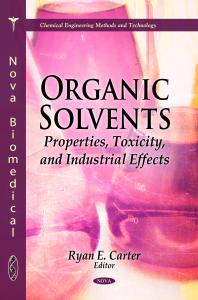(Ebook PDF) Organic Solvents Properties Toxicity and Industrial Effects Properties Toxicity and Industrial Effects 1st Edition by Ryan Carter ISBN 9781611222296 161122229X full chapters
$50.00 Original price was: $50.00.$35.00Current price is: $35.00.
(Ebook PDF) Organic Solvents Properties Toxicity and Industrial Effects Properties Toxicity and Industrial Effects 1st Edition by Ryan Carter-Ebook PDF Instant Download/Delivery:9781611222296, 161122229X
Instant download Full Chapter of Organic Solvents Properties Toxicity and Industrial Effects Properties Toxicity and Industrial Effects 1st Edition after payment

Product details:
ISBN 10:161122229X
ISBN 13:9781611222296
Author: Ryan E. Carter
Table of Contents:
-
Chapter 1: Co-Solvent Application for Biological Systems
- Abstract
- 1. Introduction
- 2. Solvent Effect Overview
- Applications of Co-Solvents
- A. Enhancing Protein Stability
- B. Protein Biopharmaceuticals
- C. Chromatography
- D. Sub-Zero Temperature Enzymology
- E. Application of Organic Solvents for NMR Studies
- F. Powder Enzyme Reaction in Organic Solvent: Low Water Activity
- G. Protein Precipitation
- H. Virus Inactivation and Processing
- i. Virus Inactivation
- ii. Virus and Plasmid Processing/Purification
- Conclusion
- References
-
Chapter 2: Lipase-Catalyzed Synthesis of Edible Surfactants in Microaqueous Organic Solvents
- Abstract
- Introduction
- 1. Equilibrium Constant for Lipase-Catalyzed Condensation of Saccharide and Lauric Acid in Water-Miscible Organic Solvents in a Batch Reaction
- 2. Continuous Production of Acyl Mannoses by Immobilized Lipase Using a Packed-Bed Reactor and Their Surfactant Properties
- 3. Syntheses of Lauroyl Phenolic Glycosides by Immobilized Lipase in Organic Solvents and Their Antioxidative Activities
- Conclusion
- Acknowledgments
- References
-
Chapter 3: Analysis of the Organic Solvent Effect on the Structure of Dehydrated Proteins by Isothermal Calorimetry, Differential Scanning Calorimetry, and FTIR Spectroscopy
- Abstract
- 1. Background and Significance
- 2. Methodology
- 2.1. FTIR Spectroscopy
- 2.2. Isothermal Calorimetry
- 2.3. Differential Scanning Calorimetry
- 2.4. Solubility Control
- 2.5. Water Content of Organic Solvents
- 3. Dried Proteins in Anhydrous Organic Solvents
- 3.1. Choice of Proteins
- 3.2. Choice of Organic Solvents
- 3.3. Solvent Hydrophilicity
- 3.4. Definition of the System Under Study
- 3.5. Analysis and Band Assignment of Protein Infrared Spectra
- 3.6. Interaction Enthalpies of the Dried Proteins with Organic Solvents
- 3.7. Effect of Solvent Hydrophilicity on Enthalpy and Integral Absorbance Changes
- 3.8. Differential Scanning Calorimetry Study
- 3.9. Effect of Hydrogen Bond Accepting Ability
- 3.10. Effect of Hydrogen Bond Donating Ability
- 3.11. Effect of Organic Solvents on the Structure of Dehydrated Proteins
- Acknowledgments
- References
-
Chapter 4: Organic-Solvent Tolerant Gram-Positive Bacteria: Applications and Mechanisms of Tolerance
- Abstract
- 1. Introduction
- 2. Predicting Solvent Toxicity
- 3. Organic-Solvent Tolerance in Gram-Positive Bacteria
- 3.1. Environmental Niches for Isolation of Tolerant Bacteria
- 3.2. Bacterial Mechanisms of Tolerance and Adaptation to Organic Solvents
- 3.2.1. Biodegradation of Toxic Compounds
- 3.2.2. Adaptation by Cell Wall and Membrane Modifications
- i. Fatty Acid Composition
- ii. Mycolic Acid Composition
- 3.2.3. Efflux Pumps and Other Mechanisms
- Conclusions
- Acknowledgments
- References
-
Chapter 5: Toxicity of Organic Solvents and Ionic Liquids to Lactic Acid-Producing Microbes
- Abstract
- Introduction
- 1. Toxicity of Organic Solvents to Lactic Acid-Producing Microbes
- 2. Toxicity of Imidazolium-Based Ionic Liquids on Lactic Acid-Producing Bacteria
- 3. Greenness of Ionic Liquids as an Alternative Solvent
- Conclusion
- References
-
Chapter 6: Effect of Hydrogen Bond Accepting Organic Solvents on the Binding of Competitive Inhibitor and Storage Stability of α-Chymotrypsin
- Abstract
- 1. Background and Significance
- 2. Binding of Competitive Inhibitor Proflavin and Storage Stability of α-Chymotrypsin in Organic Solvents
- 2.1. Choice of Organic Solvents
- 2.2. Thermodynamic Activity of Water in Organic Solvents
- 2.3. Binding of Proflavin in Water
- 2.4. Spectra of Proflavin in Water-Organic Mixtures
- 2.5. Binding of Proflavin in Organic Solvents
- 2.6. Enzyme Storage Stability
- 2.7. Hydrogen Bond Network of Water in Hydrogen Bond Accepting Organic Solvents (FTIR)
- 2.8. Excess Partial Molar Quantities of Water and Organic Solvents
- 2.9. Effect of Organic Solvents on Storage Stability and Competitive Inhibitor Binding
- References
-
Chapter 7: Regularities of Organic Solvent Penetration into Tetrafluoroethylene-Propylene Copolymer
- Abstract
- References
-
Index
People also search:
organic solvents list
organic solvents hazards
toxic organic solvents
organic solvents characteristics
organic solvents by polarity
Tags:
Ryan Carter,Organic Solvents,Properties,Toxicity,Industrial Effects


